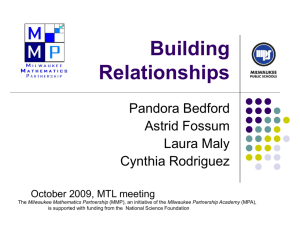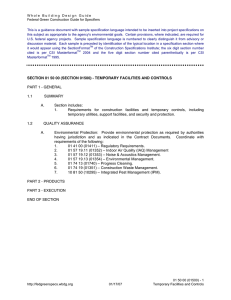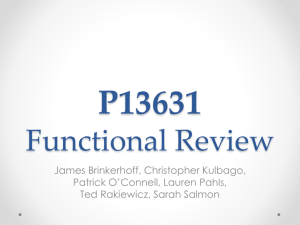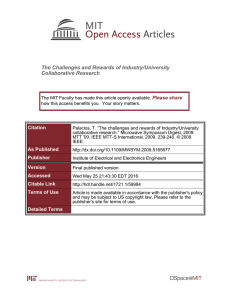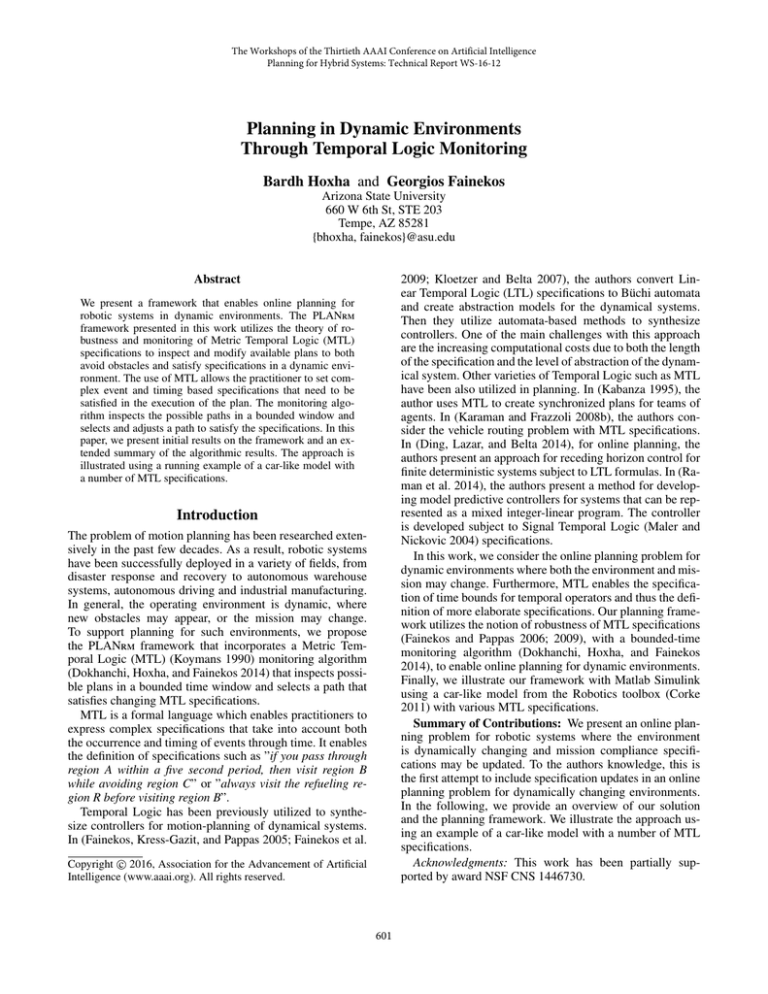
The Workshops of the Thirtieth AAAI Conference on Artificial Intelligence
Planning for Hybrid Systems: Technical Report WS-16-12
Planning in Dynamic Environments
Through Temporal Logic Monitoring
Bardh Hoxha and Georgios Fainekos
Arizona State University
660 W 6th St, STE 203
Tempe, AZ 85281
{bhoxha, fainekos}@asu.edu
Abstract
2009; Kloetzer and Belta 2007), the authors convert Linear Temporal Logic (LTL) specifications to Büchi automata
and create abstraction models for the dynamical systems.
Then they utilize automata-based methods to synthesize
controllers. One of the main challenges with this approach
are the increasing computational costs due to both the length
of the specification and the level of abstraction of the dynamical system. Other varieties of Temporal Logic such as MTL
have been also utilized in planning. In (Kabanza 1995), the
author uses MTL to create synchronized plans for teams of
agents. In (Karaman and Frazzoli 2008b), the authors consider the vehicle routing problem with MTL specifications.
In (Ding, Lazar, and Belta 2014), for online planning, the
authors present an approach for receding horizon control for
finite deterministic systems subject to LTL formulas. In (Raman et al. 2014), the authors present a method for developing model predictive controllers for systems that can be represented as a mixed integer-linear program. The controller
is developed subject to Signal Temporal Logic (Maler and
Nickovic 2004) specifications.
In this work, we consider the online planning problem for
dynamic environments where both the environment and mission may change. Furthermore, MTL enables the specification of time bounds for temporal operators and thus the definition of more elaborate specifications. Our planning framework utilizes the notion of robustness of MTL specifications
(Fainekos and Pappas 2006; 2009), with a bounded-time
monitoring algorithm (Dokhanchi, Hoxha, and Fainekos
2014), to enable online planning for dynamic environments.
Finally, we illustrate our framework with Matlab Simulink
using a car-like model from the Robotics toolbox (Corke
2011) with various MTL specifications.
Summary of Contributions: We present an online planning problem for robotic systems where the environment
is dynamically changing and mission compliance specifications may be updated. To the authors knowledge, this is
the first attempt to include specification updates in an online
planning problem for dynamically changing environments.
In the following, we provide an overview of our solution
and the planning framework. We illustrate the approach using an example of a car-like model with a number of MTL
specifications.
Acknowledgments: This work has been partially supported by award NSF CNS 1446730.
We present a framework that enables online planning for
robotic systems in dynamic environments. The PLANrm
framework presented in this work utilizes the theory of robustness and monitoring of Metric Temporal Logic (MTL)
specifications to inspect and modify available plans to both
avoid obstacles and satisfy specifications in a dynamic environment. The use of MTL allows the practitioner to set complex event and timing based specifications that need to be
satisfied in the execution of the plan. The monitoring algorithm inspects the possible paths in a bounded window and
selects and adjusts a path to satisfy the specifications. In this
paper, we present initial results on the framework and an extended summary of the algorithmic results. The approach is
illustrated using a running example of a car-like model with
a number of MTL specifications.
Introduction
The problem of motion planning has been researched extensively in the past few decades. As a result, robotic systems
have been successfully deployed in a variety of fields, from
disaster response and recovery to autonomous warehouse
systems, autonomous driving and industrial manufacturing.
In general, the operating environment is dynamic, where
new obstacles may appear, or the mission may change.
To support planning for such environments, we propose
the PLANrm framework that incorporates a Metric Temporal Logic (MTL) (Koymans 1990) monitoring algorithm
(Dokhanchi, Hoxha, and Fainekos 2014) that inspects possible plans in a bounded time window and selects a path that
satisfies changing MTL specifications.
MTL is a formal language which enables practitioners to
express complex specifications that take into account both
the occurrence and timing of events through time. It enables
the definition of specifications such as ”if you pass through
region A within a five second period, then visit region B
while avoiding region C” or ”always visit the refueling region R before visiting region B”.
Temporal Logic has been previously utilized to synthesize controllers for motion-planning of dynamical systems.
In (Fainekos, Kress-Gazit, and Pappas 2005; Fainekos et al.
c 2016, Association for the Advancement of Artificial
Copyright Intelligence (www.aaai.org). All rights reserved.
601
Preliminaries
falsified) for a particular system output trajectory. In the following, we use the notation [[ϕ]] to denote the robustness estimate with which µ satisfies the specification ϕ. In addition
to the boolean semantics, the robustness measure ρ defines
how robustly µ satisfies or falsifies ϕ.
Formally, we define the robust semantics of MTL<+∞
+pt as
follows. Using a metric d (Seda and Hitzler 2008), we can
define a distance function that captures how far away a point
x ∈ X is from a set S ⊆ X.
Metric Temporal Logic
Metric Temporal Logic (Koymans 1990) enables reasoning
over quantitative timing properties of boolean signals. In this
paper, we use the standard fragment of MTL with bounded
future, but also we allow the use of past time operators. In
the following, we assume we a constant sampling rate for
the robot and thus any specification on time reduces to a
specification on sampling points.
Definition 1 (MTL<+∞
+pt Syntax) Let AP be the set of atomic
propositions and I be any non-empty interval of N, and I
be any non-empty interval of N ∪ {+∞}. The set MTL<+∞
+pt
formulas is inductively defined as
Definition 2 (Signed Distance) Let x ∈ X be a point, S ⊆
X be a set and d be a metric. Then, we define the Signed
Distance from x to S to be
(
ϕ ::= > | p | ¬ϕ | ψ ∨ ϕ | ψUI ϕ | ψSI ϕ
Distd (x, S ) :=
where p ∈ AP and > stands for true.
Using Definition 2, we provide the formal definition for
the robustness semantics.
Definition 3 (MTL<+∞
+pt Robustness Semantics) Let s be a
trace s : N → X, and O be an observation map O : AP →
P(X), then the robust semantics of any formula ϕ ∈ MTL<+∞
+pt
with respect to s is recursively defined as:
(Next) as ϕ ≡ >U[1,1] ϕ
^ (Eventually) as ^I ϕ ≡ >UI ϕ
(Always) as I ϕ ≡ ¬^I ¬ϕ
The intuitive meaning of the ψU[a,b] ϕ operator at sampling
time i is a follows: ψ has to hold at least until ϕ becomes true
within the time interval of [i + a, i + b] in the future.
Past operators:
[[>]](s, i) := +∞
[[p]](s, i) := Distd (s(i), O(p))
~¬ϕ(s, i) := −~ϕ(s, i)
~ψ ∨ ϕ(s, i) := ~ψ(s, i) t ~ϕ(s, i)
j−1
Gi+u ~ψU[l,u] ϕ(s, i) :=
~ϕ(s, j) u
~ψ(s, k)
(Previous) as ϕ ≡ >S[1,1] ϕ
(Eventually in the past) as I ϕ ≡ >SI ϕ
Iϕ
if x < S
if x ∈ S
where inf is the infimum.
The propositional operators conjunction (∧) and implication (→) are defined the usual way. Other temporal operators
are defined as follows.
Future operators:
(Always in the past) as
− inf{d(x, y) | y ∈ S }
inf{d(x, y) | y ∈ X\S }
j=i+l
≡ ¬I ¬ϕ
~ψS[l0 ,u0 i ϕ(s, i) :=
Gi−l0
The intuitive meaning of the ψS[a,b] ϕ operator at sampling
time i is as follows: since ϕ became true in the past interval
[i − b, i − a], ψ must hold till now (current time i).
The atomic propositions in our case label subsets of the
output space Y. Each atomic proposition is a shorthand for
an arithmetic expression of the form p ≡ g(y) ≤ c, where
g : Y → R and c ∈ R. We define an observation map O :
AP → P(Y) such that for each p ∈ AP the corresponding
set is O(p) = {y | g(y) ≤ c} ⊆ Y.
j=max{0,i−u0 }
k=i
~ϕ(s, j) u
i
k= j+1
~ψ(s, k)
where t stands for max, u stands for min, p ∈ AP, l, u, l0 ∈ N
and u0 ∈ N ∪ {∞}. Furthermore, the symbol i in S[l0 ,u0 i will
be ) when u0 = +∞ and ] when u0 , +∞.
Monitoring of MTL<+∞
+pt Formulas
Robustness of MTL<+∞
+pt Formulas
The monitoring algorithm, formally presented in
(Dokhanchi, Hoxha, and Fainekos 2014), enables the
online robustness estimation of MTL<+∞
+pt formulas during
system execution or simulation. Given a MTL<+∞
+pt formula
ϕ and a current time state sequence step i, the algorithm
determines the number of time steps needed in the future
(resp. past) needed to compute the robustness of ϕ. We refer
to the number of time steps as the window size. Next, a
dynamic algorithm is utilized to calculate the robustness estimate. The future (resp. past) window size for specification
ϕ is called the horizon (resp. history) and denoted by hrz(ϕ)
(resp. hst(p)). The finite horizon and the history are defined
recursively as follows:
The robustness estimate, formally presented in (Fainekos
and Pappas 2009; Abbas et al. 2013), is used to indicate how
well a signal satisfies (or falsifies) MTL specifications. In
the rest of the paper, we will use the terms time state sequence and (execution or simulation) trace interchangeably.
We define a timed state sequence as µ = µ0 µ1 µ2 . . . µm where
µi = (τi , si ) represents a tuple of the time stamp and the vector containing the values of the state variables at sampling
instance i. Given a timed state sequence µ of a system output trajectory and a MTL specification ϕ, the robustness estimate returns a value ρ ∈ R ∪ {−∞, ∞}. A positive (resp.
negative) robustness means that the system is satisfied (resp.
602
inputs
offline/rarely called
global planner
online/runtime
state
Local MTL
Specification
Local RRT
Planner (2)
local
paths
Global
Planner (1)
Global LTL
Specification
global
map
Environment
Map
Finite Horizon
Local MTL Planner
MTL
Monitoring
(3)
feasible
paths
Path
Evaluation
Metric (4)
Robotic
System
vehicle
inputs
local sensing/update map
Figure 1: The planning process using the PLANrm framework.
Horizon:
hrz(p) = 0
hrz(¬ψ) = hrz(ψ)
hrz(ψ OP ϕ) = max{hrz(ψ), hrz(ϕ)}
hrz(ψU[l,u] ϕ) = max{hrz(ψ) + u − 1, hrz(ϕ) + u}
hrz(ψS[l0 ,u0 i ϕ) = max{hrz(ψ), hrz(ϕ)}
History:
hst(¬ψ) = hst(ψ)
hst(ψU[l,u] ϕ) = max{hst(ψ), hst(ϕ)}
hst(ψ OP ϕ) = max{hst(ψ), hst(ϕ)}
hst(ψS[l0 ,u0 i ϕ) =
(
max{hst(ψ) + u0 − 1, hst(ϕ) + u0 }
max{hst(ψ) + l0 − 1, hst(ϕ) + l0 }
However, at this point, we must make sure that the future
obligations from the local MTL requirements are preserved.
In the following, we review motion planning over LTL
specifications and then we provide an overview of our online planning framework for solving Problem 1 through an
example.
Review of LTL Planning
Motion planning over LTL specifications has a long history (Loizou and Kyriakopoulos 2004; Fainekos, KressGazit, and Pappas 2005; Kloetzer and Belta 2007; Karaman and Frazzoli 2008a; Bhatia, Kavraki, and Vardi 2010;
Plaku and McMahon 2013). One of the earliest works in LTL
planning in robotics appears in (Lamine and Kabanza 2002).
There, the authors use LTL runtime monitoring to check for
violations of LTL specifications while the robot executes its
plan. Also, the framework includes a simulation based planner with LTL goals in order to choose a behavior that would
best satisfy the LTL goals.
A general approach to the high-level planning problem
with LTL is as follows. First, a discretized abstraction M
of the workspace using decomposition techniques is generated (Fainekos, Kress-Gazit, and Pappas 2005). Then, the
LTL specification is converted into a Büchi automaton B.
Next, a search algorithm over the product automaton M × B
is utilized to find a feasible plan. In the LTL planning framework, partially known environments can be handled as well.
For example, see the recent work in (Guo, Johansson, and
Dimarogonas 2013), where the authors present an approach
to locally update the product automaton when the environment changes. Closer in spirit to our work are the works by
(Plaku, Kavraki, and Vardi 2009; Bhatia, Kavraki, and Vardi
2010), where the authors present an approach that combines
high-level planners with sampling-based low-level planners
to explore for feasible paths that satisfy LTL specifications.
In general, finding a tractable method for motion planning over MTL requirements is still an open problem. The
approach utilized for LTL formulas is not feasible for MTL.
MTL formulas can be represented by timed automata (Alur
if u0 , +∞
if u0 = +∞
where p ∈ AP. Here, OP is any binary operator in propositional logic, and ψ, ϕ are MTL<+∞
+pt formulas.
Problem Formulation
Our high level goal is to provide an online planning framework for dynamic environments where part of the mission
specifications may be updated. We aim to do so by utilizing
the notion of robustness and monitoring of MTL specifications. Formally, we aim to solve the following problem:
Problem 1 Given a model of a robotic system Σ and a path
p that satisfies an LTL formula ϕ, design an online controller which computes local paths which still satisfy ϕ and,
moreover, they satisfy a set {ψi } of potentially dynamically
changing local MTL mission requirements in a dynamically
changing environment.
The planning framework is presented in Fig. 1. Given a
global LTL specification ϕ, a global planner is utilized to
generate a path from the initial position to the goal position that satisfies ϕ. Then, the online, finite horizon local
MTL planner generates plans that take into account potentially changing MTL specifications until the destination is
reached. In certain conditions, the local planner may not
find a valid local path that satisfies the specification. In those
cases, an updated plan from the global planner is requested.
603
100
100
100
90
90
90
80
80
70
70
60
60
50
50
80
70
y
y
60
50
40
40
30
30
20
20
10
10
40
30
20
10
0
0
0
0
0
10
20
30
40
50
60
70
80
90
10
20
30
40
50
60
70
80
90
100
0
10
20
30
40
50
x
100
60
70
80
90
100
x
Figure 2: Left: Environment map with the initial position for the robot (yellow) at xinit = (10, 10, π) and the goal position for
the robot (green) at xgoal = (90, 90, 0). Middle: RRT generated on the configuration space considering the vehicle dynamics.
Right: Best path based on the RRT from xinit to xgoal .
T = 60s
T = 90s
90
90
90
90
80
80
80
80
70
70
70
70
60
60
60
60
50
50
50
50
y
100
y
100
40
40
40
40
30
30
30
30
20
20
20
20
10
10
10
0
0
0
10
20
30
40
50
60
70
80
90
100
10
0
0
10
20
30
40
x
50
60
70
80
90
100
0
0
10
20
30
40
x
T = 120s
50
60
70
80
90
100
0
T = 150s
80
80
80
80
70
70
70
70
60
60
60
60
50
50
50
50
y
90
y
100
90
40
40
40
40
30
30
30
30
20
20
20
20
10
10
10
0
20
30
40
50
x
60
70
80
90
100
10
20
30
40
50
60
70
80
90
100
60
70
80
90
100
70
80
90
100
0
0
x
50
10
0
0
40
T = 240s
100
90
10
30
T = 180s
100
0
20
x
90
0
10
x
100
y
y
T = 75s
100
y
y
T = 15s
100
10
20
30
40
50
x
60
70
80
90
100
0
10
20
30
40
50
60
x
Figure 3: Vehicle progression from xinit = (10, 10, π) to xgoal = (90, 90, 0) at various times in the path traversal. The blue path
represents the shortest path obtained by the global planner. The green path represents the path traversed by the vehicle. The red
regions represent areas where the vehicle should not go through. Also, every time the vehicle is in the yellow set then within
the next 20s the vehicle should enter set blue set.
and Dill 1994) and currently algorithms exist only for fragments of MTL (Maler, Nickovic, and Pnueli 2006). Therefore, in this work, we utilize LTL for the global specification.
Fig. 1. First, a global planner (1) is utilized to generate paths
considering the environment and system dynamics. For example, using the framework presented in (Bhatia, Kavraki,
and Vardi 2010). Then, the global plan is executed. If there
are any local MTL formulas that must be satisfied, then a local RRT planning framework is executed. The Local Planner
(2) generates paths from the current system location, while
considering a dynamically changing environment and specification. The set of paths generated are then classified as
feasible and infeasible through MTL Monitoring (3). Out of
the feasible local plans, in the Path Evaluation Metric (4)
stage, the framework choses the one that most closely corresponds to the global established path. Here, we can utilize
a weighted average of the robustness metric, in conjunction
with a similarity measure, such as the euclidean distance,
to chose one path from the set of feasible paths. It is important to note that the local plan needs to stay close to
the global plan, either in terms of path distance, regions or
Planning in Dynamic
Environments and Specifications
In real world applications of robotic systems, both the environment and the mission can change dynamically as the
system is running. In the latter case, we assume that such
changes are defined as MTL specifications. We aim to utilize
history and horizon window sizes for MTL specifications to
determine the timespan for the local plan generator in order
to generate specification compliant plans. For the local planner, we utilize MTL since it can capture specifications that
include timing intervals for temporal operators. In many applications it is often necessary to capture timing properties.
We present an overview of the planing framework in
604
P
control points such that H = ni=1 ti . This method is aimed to
improve the smoothness of the trajectories generated as opposed to general RRT methods. This local planning method
is illustrated in Figure 4. To generate the RRT, we utilize a
slightly modified version of the algorithm provided in the
Robotics Toolbox (Corke 2011). The spread-based method
utilized is inspired by the works presented in (Von Hundelshausen et al. 2008; Yu et al. 2012) which may be used to
generate smooth vehicle motion plans.
The set of trajectories generated from the local planner
are then tested over the specifications using the MTL Monitoring (3) algorithm. We use S-TaLiRo (Annapureddy et al.
2011; Hoxha et al. 2014) to conduct the robustness computation over MTL formulas. In Figure 4, we illustrate this
process with the specification ϕ = (a → ^[0,2] b) where a is
the set [10, 12] × [9, 11] and b is the set [13, 15] × [12, 14].
Once the set of feasible trajectories is provided, we utilize the Path Evaluation Metic (4) to choose the best path.
Here, we can utilize the robustness metric, in conjunction
with a trajectory similarity measure, to choose a path that
corresponds closely to the global path provided by the global
planner. We refer to this as the selection criterion. In our example, we utilize a weighted average of the robustness metric and the similarity measure. For a similarity measure, we
utilize a Euclidean distance
P measure, i.e. for two trajectories
T 1 and T 2 , Ed (T 1 , T 2 ) = ni=1 k(T 1 (i), T 2 (i))k /n, where T (i)
represents the vehicle position at time i.
Determining the best selection criterion is a challenging
problem, since non-optimal choices may lead to livelock situations where the vehicle moves but does not make overall
progress towards the goal. If a livelock does happen, it is
important to detect it and mitigate the issue by possibly requesting a new plan from the global planner. This topic will
be covered in future work.
some other high-level abstraction. In case no feasible paths
are found, the Local Planer (2) requests an update from the
global planner (1) and the process repeats until the destination is reached.
To illustrate the approach we utilize the car-like model
from the Robotics Toolbox (Corke 2011). A rear wheel is
fixed to the body, and a front wheel which rotates to steer
the vehicle. We assume that the vehicle only moves forward.
The configuration of the vehicle is represented by generalized coordinates q = (x, y, θ) ∈ C ⊂ S E(2). The kinematic
model of the vehicle is presented with the following equations of motion:
ẋ = v cos θ
ẏ = v sin θ
v
θ̇ = tan γ
L
where (x, y, θ) represent the (x, y) position and θ orientation of the robot, v represents the forward speed, L represents the length of the vehicle and γ is the steering angle. In
our study, the only input to the system is the steering angle
with a constant velocity. For more details on the model see
(Corke 2011). The Matlab Simulink model is also provided
in the toolbox. In Fig. 2 we present the environment along
with the initial and goal positions. We also present the global
plan generated using an RRT algorithm.
In Figure 3, we illustrate vehicle progression in a dynamically changing environment and mission specification. The
mission goal is to go from initial position xinit = (10, 10, π)
to xgoal = (90, 90, 0). At T = 15s, a specification φ = ¬a
is introduced where a is the set [30, 40] × [40, 60]. The
specification states that set a should never be visited. At
T = 60s and T = 75s, the local planner generates a path
that avoids set a. At T = 90s, the specification is updated to
φ = (¬a ∧ ¬b), where b is the set [70, 80] × [40, 60]. At
T = 120s, the local planner fails to find a path towards xgoal
and therefore requests an updated global plan. The global
planner then presents a new route to xgoal . At T = 150s,
the specification is updated to φ = (¬a ∧ ¬b) ∧ (c →
^[0,20] d), where c is the set [40, 50] × [60, 70] and d is the set
[30, 40] × [70, 80]. In addition to the previous specification,
the updated specification states that every time the vehicle
is in set c then within the next 20s the vehicle should enter
set d. At T = 120s, the local planner provides a plan that
satisfies the specification. It should be noted that it strays
away from the plan provided by the global planner in order
to satisfy the updated specification. At T = 240s, the vehicle
reaches the destination.
In practice, when an updated local MTL specification is
received, we should verify that it does not contradict the
global LTL specification. In certain scenarios, we can utilize
the work presented in (Fainekos 2011; Dokhanchi, Hoxha,
and Fainekos 2015) to detect and debug contradictory or inconsistent specifications.
The Local Planner (2) used in this framework generates
a set of trajectories by slightly modifying the steering angle
at a number of control points within the specification horizon/history window. Namely, given a horizon/history window size H, the steering angle is modified at ti equidistant
Conclusion and Future Work
In this work, we presented an overview of the framework
that enables online planning for robotic systems in dynamic
environments where the mission specification may change
during system operation. We illustrated the framework on a
car-like model from the Robotics Toolbox (Corke 2011).
As future work, we will consider the challenges presented
in the previous section. In certain situations, when no feasible paths are presented by the local planner, an updated
global path is requested by the global planner. However, in
those cases, the future obligations from the local MTL specification should be maintained. Also, we will investigate candidates for the selection criterion and conduct experimental results to evaluate them. We will also investigate methods for determining livestock conditions and how to resolve
them. Finally, we plan to utilize the PLANrm framework on
a more complex hybrid system and evaluate the performance
and computational overhead during this process.
References
Abbas, H.; Fainekos, G. E.; Sankaranarayanan, S.; Ivancic,
F.; and Gupta, A. 2013. Probabilistic temporal logic falsi-
605
RRT-Based Local Planner
14
13
13
12
12
11
11
10
10
y
y
Spread-Based Local Planner
14
9
9
8
8
7
7
6
6
9
10
11
12
13
14
15
16
17
9
10
11
12
x
13
14
15
16
17
14
15
16
17
x
14
14
13
13
12
12
11
11
10
10
y
y
Fainekos, G.; Girard, A.; Kress-Gazit, H.; and Pappas, G. J.
2009. Temporal logic motion planning for dynamic robots.
Automatica 45(2):343–352.
Fainekos, G. E.; Kress-Gazit, H.; and Pappas, G. J. 2005.
Temporal logic motion planning for mobile robots. In
Robotics and Automation, 2005. ICRA 2005. Proceedings
of the 2005 IEEE International Conference on, 2020–2025.
IEEE.
Fainekos, G. E. 2011. Revising temporal logic specifications
for motion planning. In Robotics and Automation (ICRA),
2011 IEEE International Conference on, 40–45. IEEE.
Guo, M.; Johansson, K. H.; and Dimarogonas, D. V. 2013.
Revising motion planning under linear temporal logic specifications in partially known workspaces. In Robotics and Automation (ICRA), 2013 IEEE International Conference on,
5025–5032. IEEE.
Hoxha, B.; Bach, H.; Abbas, H.; Dokhanchi, A.; Kobayashi,
Y.; and Fainekos, G. 2014. Towards formal specification
visualization for testing and monitoring of cyber-physical
systems. In Int. Workshop on Design and Implementation
of Formal Tools and Systems.
Kabanza, F. 1995. Synchronizing multiagent plans using
temporal logic specifications. In Lesser, V., ed., Proceedings of the First International Conference on Multi–Agent
Systems, 217–224. San Francisco, CA: MIT Press.
Karaman, S., and Frazzoli, E. 2008a. Complex mission
optimization for multiple-uavs using linear temporal logic.
In American Control Conference, 2008, 2003–2009. IEEE.
Karaman, S., and Frazzoli, E. 2008b. Vehicle routing problem with metric temporal logic specifications. In Decision
and Control, 2008. CDC 2008. 47th IEEE Conference on,
3953–3958. IEEE.
Kloetzer, M., and Belta, C. 2007. Temporal logic planning
and control of robotic swarms by hierarchical abstractions.
Robotics, IEEE Transactions on 23(2):320–330.
Koymans, R. 1990. Specifying real-time properties with
metric temporal logic. Real-Time Systems 2(4):255–299.
Lamine, K. B., and Kabanza, F. 2002. Reasoning about
robot actions: A model checking approach. In Advances
in Plan-Based Control of Robotic Agents, volume 2466 of
LNCS, 123–139. Springer.
Loizou, S. G., and Kyriakopoulos, K. J. 2004. Automatic
synthesis of multi-agent motion tasks based on LTL specifications. In Proceedings of the 43rd IEEE Conference on
Decision and Control.
Maler, O., and Nickovic, D. 2004. Monitoring temporal properties of continuous signals. In Proceedings of
FORMATS-FTRTFT, volume 3253 of LNCS, 152–166.
Maler, O.; Nickovic, D.; and Pnueli, A. 2006. From MITL
to Timed Automata. In Proceedings of FORMATS, volume
4202 of LNCS, 274–289. Springer.
Plaku, E., and McMahon, J. 2013. Combined mission and
motion planning to enhance autonomy of underwater vehicles operating in the littoral zone. In Workshop on Combining Task and Motion Planning at IEEE International Conference on Robotics and Automation (ICRA13).
9
9
8
8
7
7
6
6
9
10
11
12
13
x
14
15
16
17
9
10
11
12
13
x
Figure 4: Top: Left: Local planner used in the bicycle model
example for generating smooth and evenly distributed trajectories. Right: An additional method for generating local
plans through RRTs. Bottom: Trajectories that satisfy (resp.
falsify) specification ϕ = (a → ^[0,2] b) represented in blue
(resp. red) where a is the set [10, 12] × [9, 11] and b is the
set [13, 15] × [12, 14].
fication of cyber-physical systems. ACM Trans. Embedded
Comput. Syst. 12(2s):95.
Alur, R., and Dill, D. L. 1994. Theory of timed automata.
Theoretical Computer Science 126(2):183–235.
Annapureddy, Y. S. R.; Liu, C.; Fainekos, G. E.; and
Sankaranarayanan, S. 2011. S-taliro: A tool for temporal
logic falsification for hybrid systems. In Tools and algorithms for the construction and analysis of systems, volume
6605 of LNCS, 254–257. Springer.
Bhatia, A.; Kavraki, L. E.; and Vardi, M. Y. 2010. Samplingbased motion planning with temporal goals. In International
Conference on Robotics and Automation, 2689–2696. IEEE.
Corke, P. I. 2011. Robotics, Vision & Control: Fundamental
Algorithms in Matlab. Springer.
Ding, X.; Lazar, M.; and Belta, C. 2014. Ltl receding
horizon control for finite deterministic systems. Automatica 50(2):399–408.
Dokhanchi, A.; Hoxha, B.; and Fainekos, G. 2014. Online monitoring for temporal logic robustness. In Runtime
Verification, 231–246. Springer.
Dokhanchi, A.; Hoxha, B.; and Fainekos, G. 2015. Metric
interval temporal logic specification elicitation and debugging. MEMOCODE.
Fainekos, G., and Pappas, G. J. 2006. Robustness of temporal logic specifications. In Formal Approaches to Testing
and Runtime Verification, volume 4262 of LNCS, 178–192.
Springer.
Fainekos, G., and Pappas, G. J. 2009. Robustness of temporal logic specifications for continuous-time signals. Theor.
Comput. Sci. 410(42):4262–4291.
606
Plaku, E.; Kavraki, L. E.; and Vardi, M. Y. 2009. Falsification of ltl safety properties in hybrid systems. In Proc. of
the Conf. on Tools and Algorithms for the Construction and
Analysis of Systems (TACAS), volume 5505 of LNCS, 368 –
382.
Raman, V.; Donzé, A.; Maasoumy, M.; Murray, R. M.;
Sangiovanni-Vincentelli, A.; Seshia, S.; et al. 2014. Model
predictive control with signal temporal logic specifications.
In Decision and Control (CDC), 2014 IEEE 53rd Annual
Conference on, 81–87. IEEE.
Seda, A. K., and Hitzler, P. 2008. Generalized distance functions in the theory of computation. The Computer Journal
53(4):bxm108443–464.
Von Hundelshausen, F.; Himmelsbach, M.; Hecker, F.;
Mueller, A.; and Wuensche, H.-J. 2008. Driving with tentacles: Integral structures for sensing and motion. Journal of
Field Robotics 25(9):640–673.
Yu, H.; Gong, J.; Iagnemma, K.; Jiang, Y.; and Duan, J.
2012. Robotic wheeled vehicle ripple tentacles motion planning method. In Intelligent Vehicles Symposium (IV), 2012
IEEE, 1156–1161. IEEE.
607

